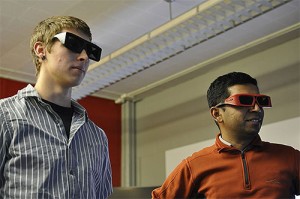
On the second floor of Stanley Hall is the home of some of the most hands-on learning that takes place on campus. It’s the Architectural Studies Department’s iLab, which is equipped with everything from an immersive large-screen 3D projection system to a driving simulator.
Professor Bimal Balakrishnan works with both undergraduate and graduate students in using this technology, and sometimes entire project ideas come from undergraduate students. “Sometimes I find undergraduates braver than grad students, especially with a combination of confidence and curiosity,” Balakrishnan said.
The program is set up so that undergraduate students can maximize their experience in the lab and build a skill set for their careers. “We are dividing up the responsibilities. I give a lot of the basic work to undergrads, but we have a system where we pair them up with graduate students so they learn. They actually get the skills to move up,” Balakrishnan said.
“Literally this thing is built by students. Students help put it all together, we just get the pieces and assemble everything ourselves.”
Balakrishnan says the goal is that students can have a real-world experience while working in the lab, which focuses heavily on collaboration—it is equipped with a professional style conference table and white board, among many other collaborative tools.
They hope to continue adding to the space, with Windows Surface tablets for everyone and technology that will allow collaborators around the world to be in the same 3D space at the same time.
The iLab started out small, and continues to grow through the years, not only adding more technology and tools, but people to use them. “Initially we had hardly any graduate students. It was all undergrads volunteering their time doing it when we didn’t have anything formalized,” Balakrishnan said.

Now that they have expanded, more graduate students and faculty have become interested. “The key is figuring out how to keep the enterprise going and at the same time expand the reach for our undergraduate students,” Balakrishnan said.
Students make up the core of the iLab, doing everything from coming up with the projects to building the lab from the ground up. “Literally this thing is built by students. Students help put it all together, we just get the pieces and assemble everything ourselves,” Balakrishnan said. And their experiences in the iLab have helped lead them toward successful careers.
“Sometimes I find undergraduates more brave than grad students, especially with a combination of confidence and curiosity.”
“Everyone who has gone through the lab, with the exception of one or two who are doing other things, are either in graduate school or have been through graduate school and have a good job. Having that experience actually helped them get good scholarships,” Balakrishnan said.
Balakrishnan and the students that work in the iLab are proud of what they’ve created, and happy to have the opportunities it provides. “Right now I think we have, compared to a lot of undergraduate schools, in terms of visualization, we have pretty decent capability,” Balakrishnan said. “It’s not perfect, but we continue to improve.”
As the faculty mentor of such a hands-on and collaborative learning experience, Balakrishnan has seen tremendous growth in many of his students over the course of their time working on projects in the iLab. “To see somebody, a student who starts out very timid with a lot of hand-holding, by the end of the semester be independent and have the courage to start something on their own and gaining creative confidence… it’s exciting stuff,” Balakrishnan said.
Photos courtesy of Bimal Balakrishnan.